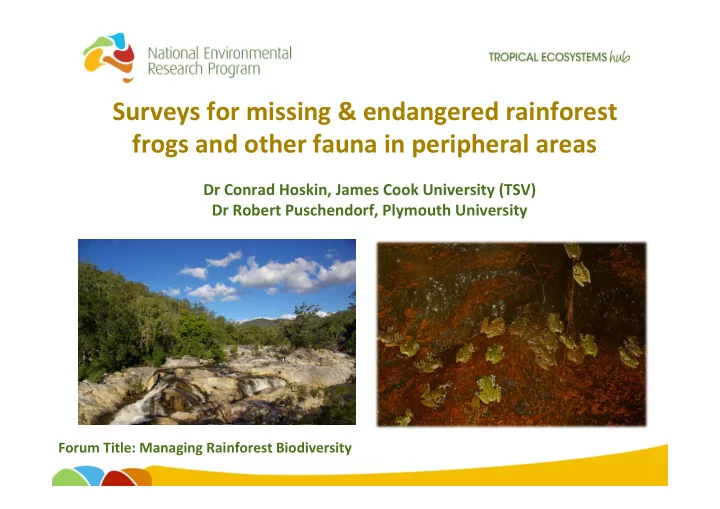

Surveys ¡for ¡missing ¡& ¡endangered ¡rainforest ¡ frogs ¡and ¡other ¡fauna ¡in ¡peripheral ¡areas ¡ Dr ¡Conrad ¡Hoskin, ¡James ¡Cook ¡University ¡(TSV) ¡ Dr ¡Robert ¡Puschendorf, ¡Plymouth ¡University ¡ Forum ¡Title: ¡Managing ¡Rainforest ¡Biodiversity ¡
RELEVANCE ¡OF ¡WORK ¡ Wet forest frogs have declined globally Principally due to chytridiomycosis disease caused by the ‘chytrid’ fungus ( Batrachochytrium dendrobatidis) Hundreds of frogs have gone extinct in last few decades! Possibly African origin, spreading globally Infects keratin: frog skin, tadpole mouthparts Ultimately overcomes frog, leading to death Populations decline suddenly, often in a single year
RELEVANCE ¡OF ¡WORK ¡ Dead Litoria serrata in Wet Tropics Australian rainforest frogs have been hit hard Photo: M. J. Tyler Many species declined suddenly through the 1980s and 1990s Rainforest stream frogs worst hit, particularly in the uplands (> 500 m) Wet Tropics : Extinct?: L. nyakalensis, T. acutirostris, T. rheophilus Rheobatrachus ‘giving birth’ Declined: L. lorica, L. nannotis, L. rheocola, L. dayi Eungella : Extinct?: Rheobatrachus vitellinus Declined: T. eungellensis, T. liemi, Adelotus brevis Taudactylus liemi, Eungella
RELEVANCE ¡OF ¡WORK ¡ T. rheophilus Photo: M. Cohen Frog declines in the Wet Tropics - patterns of persistence Lowland rainforest ( L. nannotis, L. rheocola, L. dayi ) Small upland populations ( T. rheophilus ) Peripheral dry forest areas ( L. nannotis, L. rheocola, L. lorica ) Dry forest waterfall, Carbine Tbld Litoria nannotis Rainforest !
RELEVANCE ¡OF ¡WORK ¡ Rediscovery of Litoria lorica Rediscovered by Robert Puschendorf, after 16 years Single known population, occurs in dry forest on Carbine Tableland Persisting with chytrid disease, probably due to warmer environmental temps (Puschendorf, Hoskin et al. Cons Biol. 2011) Armoured Mistfrog ( Litoria lorica ) Litoria nannotis (larger) & L. lorica (smaller)
3 The Wet Tropics 1 2 RELEVANCE ¡OF ¡WORK ¡ 2 Peripheral areas are important but poorly known in the Wet Tropics & Eungella 2 ‘Peripheral’ areas are: 1. Dry western edge of Wet Tropics & Eungella 2. Wet forest outliers 1 Isolation, and different abiotic (e.g. climate) & biotic (other species) characteristics that may have enabled persistence versus core rainforest areas of the Wet Tropics 1 3
RELEVANCE ¡OF ¡WORK ¡ Aims: 1. Search for missing & endangered frogs in peripheral areas 2. Search select historic frog sites to assess persistence of missing and endangered species ( L. lorica, T. rheophilus, R. vitellinus, L. nyakalensis, T. eungellensis ) 3. Assess disease and recovery of endangered frog species 4. Work out what to do with critically endangered frogs ( L. lorica, T. rheophilus ) 5. Search peripheral areas for other exciting vertebrates
RESULTS ¡ Sites surveyed 1-2 days/nights each Targeted streams All vertebrates recorded Select sites and frogs swabbed for chytrid fungus
Lower Bargoo Falls Adeline Falls, with croc above many waterfalls!
Lower Picaninny Falls, Windsor Tbld
RESULTS ¡ Searching for missing and critically endangered species: No sign of L. nyakalensis, T. acutirostris, T. rheophilus or R. vitellinus at historic sites or in peripheral areas Six ‘call boxes’ deployed for T. rheophilus (2 Bellenden Ker, 3 Mt Lewis) – record 1 minute of sound every hour for 4-6 months T. rheophilus Photo: M. Cohen
RESULTS ¡ Litoria lorica Despite targeted searches of all likely sites, L. lorica remains known from one site: Along approx. 4 km of stream. Total population estimated at 500-1000 adults. Monitoring since 2008 shows population is persisting well despite chytrid infection.
RESULTS ¡ Persistence of other threatened frog species: L. nannotis at most sites L. rheocola at some L. dayi at few Very high densities of L. nannotis at dry sites, even up to 1000 m elevation
RESULTS ¡ Persistence of other threatened frog species: At Eungella: T. eungellensis persists at known sites As does T. liemi Also found at a new site T. eungellensis T. liemi
RESULTS ¡ Recovery of some species back into high altitude rainforest For example: L. nannotis & L. rheocola on western Carbine Tableland
RESULTS ¡ Chytrid swabs sent away and currently being processed Results to come …
APPLICATION ¡OF ¡WORK ¡ Ecotonal & peripheral areas contain unique species, distinct lineages and populations in unique environmental settings Very important for protection and management Found many new frog populations + some evidence for recovery Focus surveys and monitoring on dry forest sites and neighbouring upland rainforest L. lorica almost certainly persists only as a single population – currently collaborating with EHP & QPWS on management Persistence of R. vitellinus, T. acutirostris, T. rheophilus and L. nyakalensis seems unlikely – select additional surveys required & call box data to be analysed
FUTURE ¡DIRECTIONS ¡ Link survey results to swabbing results Write up results Keep monitoring L. lorica and areas of apparent recovery for other species Management of L. lorica in collaboration with EHP & QPWS Download and analyse call boxes Further surveys of western central/southern Wet Tropics & Eungella Understand mechanisms of persistence & recovery (temperature hypothesis)
THANK ¡YOU ¡ NERP for funding JCU, EHP and QPWS Megan Higgie, Anders Zimny, Bungie Helicopters, David Sherwell, Sam Dibella, Brendan Malone, Andrew Millerd, Andy Baker, Alastair Freeman, Keith McDonald, David Murphy
Recommend
More recommend